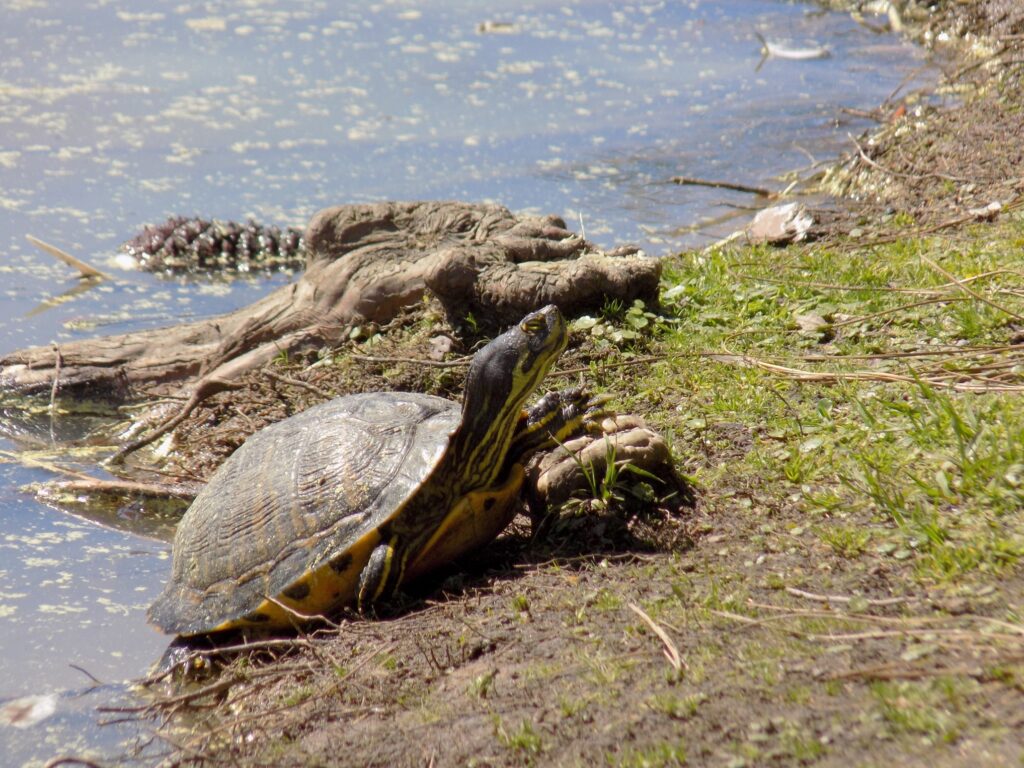
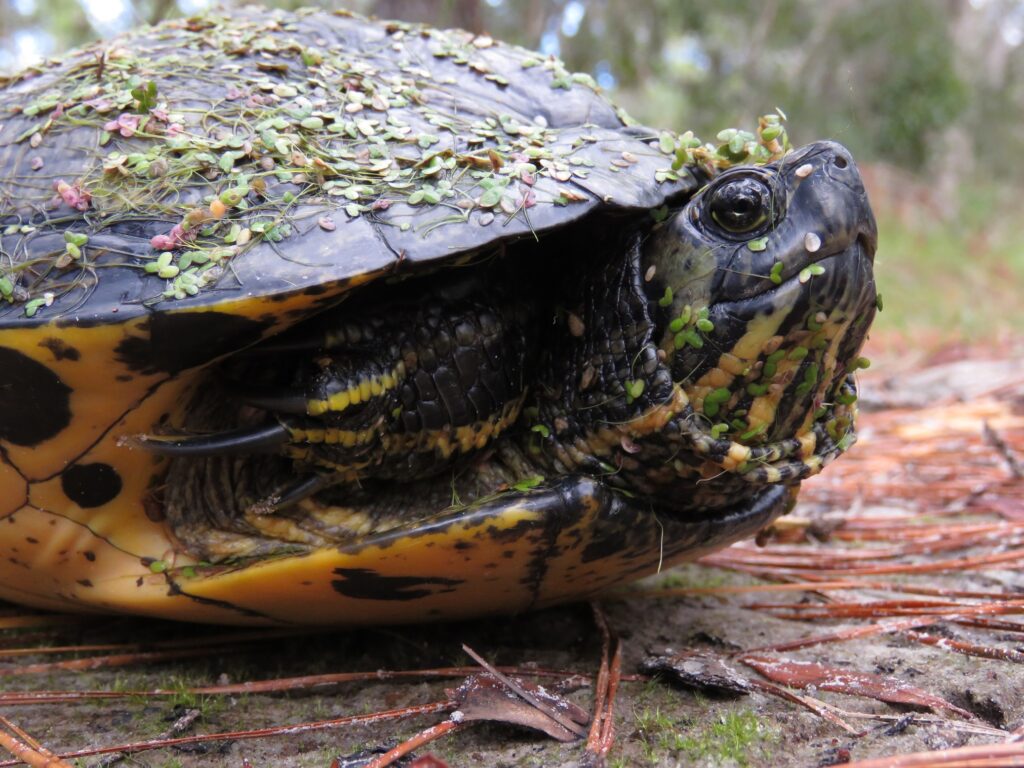
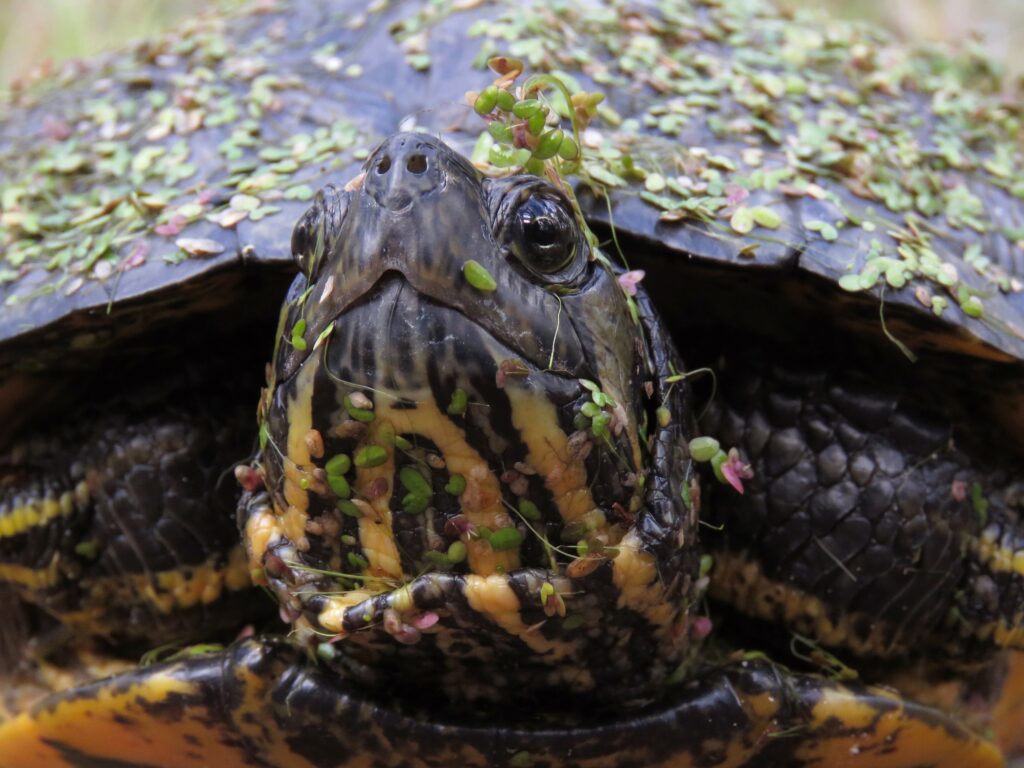
This week for Flora and Fauna Friday we have our most abundant aquatic reptile, the Yellow-bellied Slider (Trachemys scripta scripta).
The Yellow-bellied Slider is by far our most common Pond Turtle in the Lowcountry. When you think of turtles lazily lined on logs in the blazing sun or shambling around in a pet store aquarium, this is the species that comes to mind. They are a fairly large turtle that can reach twelve inches in length. Their belly is predictably yellow and their back a grungy gray-black of bumps and ridges. They’re best distinguished by their yellow sideburns, a heavy vertical band of lemon-yellow just behind the eye. The Yellow-bellied Slider has a sister subspecies that’s now found in South Carolina, called the Red-eared Slider (T. s. elegans). The Red-eared Slider is native to the Mississippi River Basin but has been spread extensively throughout the United States by the pet trade. They’re common in the upstate and around human neighborhoods but not so much in the wilds of the Lowcountry. This subspecies is easily identified by their namesake red “ear”.
The Yellow-bellied Slider appears practically anywhere there is a permanent freshwater body. That includes lakes, rivers, deepwater swamps, Carolina Bays, and parking lot retention ponds. They will eat anything they can catch or scavenge as well as some aquatic plants. They use their hardened beak and extendable neck to nab minnows, crawfish, frogs, and digits alike. This species, along with some other Pond Turtles, have an interesting method of courting a mate. The art of seductive jazz-hands. Males are smaller than females and grow long claws on their front feet. During courtship, the male will swim backwards in front of a female while rattling his claws in her face. Romantic.
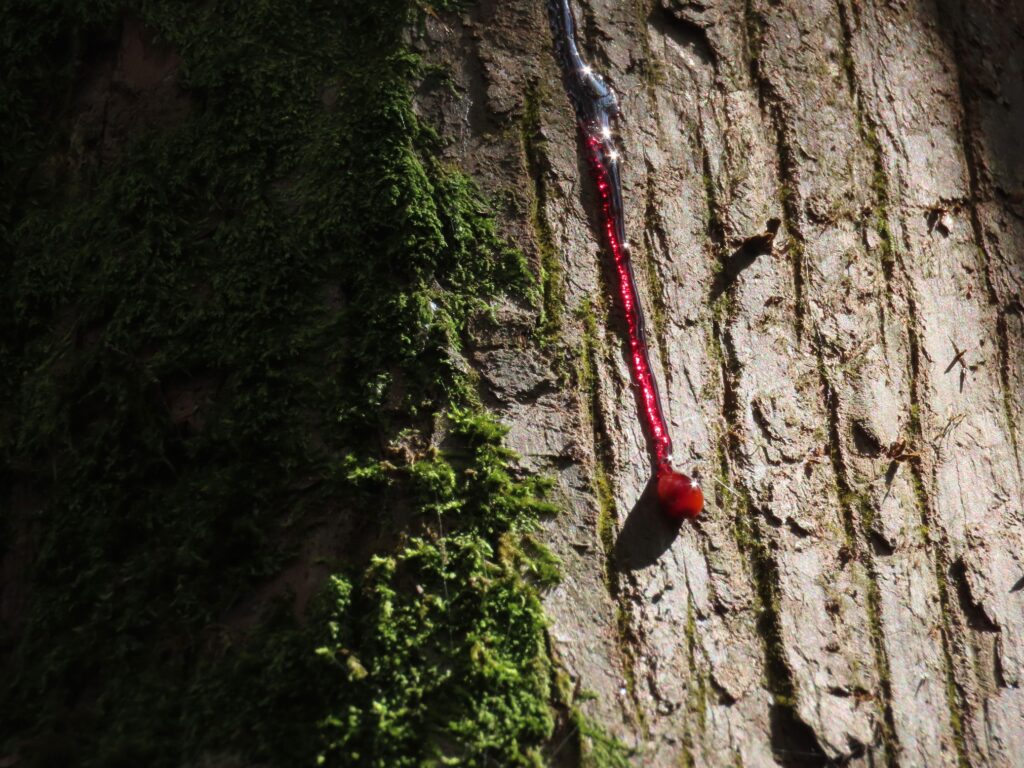
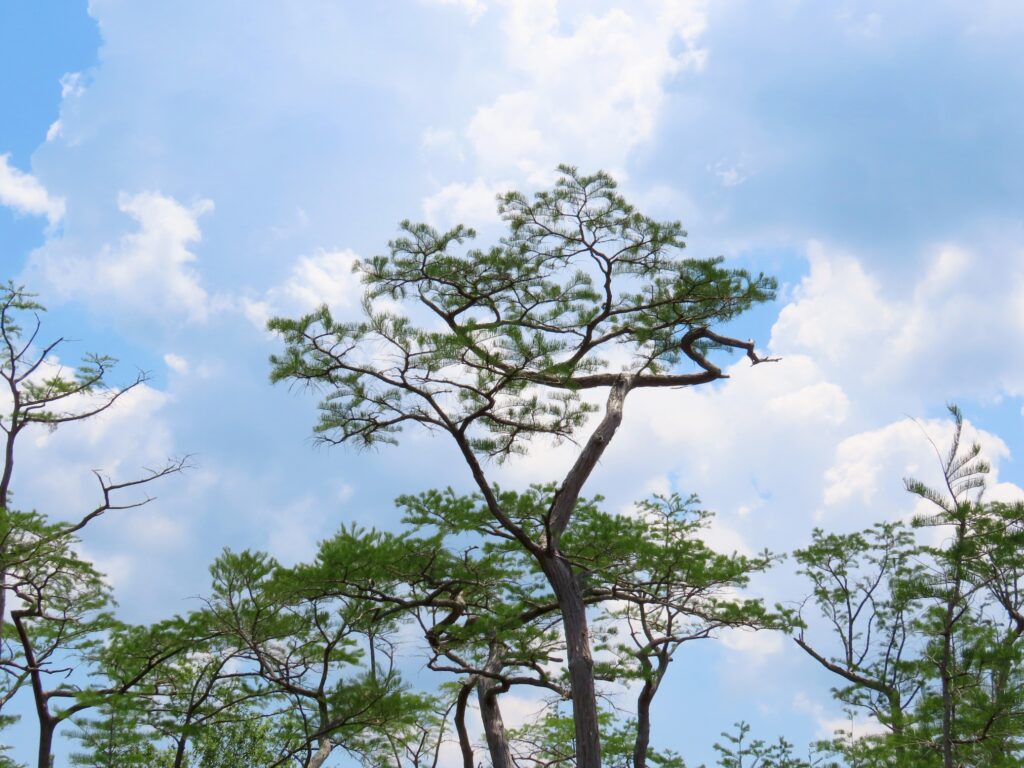

This week for Flora and Fauna Friday it’s none other than our towering titans of the swamp, the Cypresses (Taxodium spp.).
Here in the Lowcountry we have two species of Cypress, the Bald Cypress (Taxodium distichum) and the Pond Cypress (Taxodium ascendens). Both species live in forested wetlands, tolerate flooding well, are long-lived, and look similar but differ distinctly in their habitat preference and leaf shape. Bald Cypress is the quintessential species of Cypress we’re all familiar with. Huge ruddy-brown trunks on broad, buttressed bases towering over the surface of a bottomland forest in a sea of black leaf litter tea punctuated with cypress knees. That’s our Bald Cypress. They’re commonly found across the Lowcountry in permanent wetlands, especially in in bottomlands, blackwater rivers, oxbows, and floodplains. They also have feather-shaped leaves held outward from the stem, which is an easy way to distinguish them from Pond Cypress. Pond Cypress is often smaller than Bald Cypress but otherwise looks quite similar. However, its leaves are far thinner and held nearly upright on the stems. Pond Cypress is also far less common than Bald Cypress but most numerous in isolated permanent wetlands, especially Carolina Bays.
Cypresses are conifers and, like pines, produce cones. The cypress cone is a roughly inch wide ball with a segmented appearance, like the scutes of a turtle. Notably for a Lowcountry conifer, both our Cypresses are deciduous, losing their leaves in the winter. Cypresses are one of the most long-lived trees on Earth, with quite a few individuals exceeding the thousand year mark and a few breaking the two-thousand year threshold. Cypress Trees have many unique adaptations for life in the swamp. One notable feature is their buttressed trunks. This broadening of their trunk base gives them a more stable foundation in the soft, soupy soils they inhabit. Another unique adaptation are cypress knees. These are projections of the root system that extend up above the soil and water’s surface. They were originally thought to help the trees breathe in the water logged soils but scientists have been unable to find any evidence of the knees breathing. Current theories believe they help further stabilize the tree in the soil as well capture sediment beneath the tree. Cypresses also have one of the most rot resistant woods, allowing trees to stand for centuries without collapsing for them inside out. This made them an important timber species historically before the advent of treated lumber. Today, they still remain an economically important timber species in Florida for producing lumber for outdoor use in humid climates.

This week for Flora and Fauna Friday it’s our pale-plumaged beach-combing shorebird, the Willet (Tringa semipalmata).
The Willet is a large shorebird found on beaches and mudflats across the coastal United States and a common shorebird here on Edisto Island. Willets stand about a foot tall on long pale-gray legs. In winter their plumage is a solid pattern of blended muted-brown, gray, and white and, in summer, the same but with black speckling. Their bill is rather long, arrow-straight, and two-tone gray at the base and black near the tip. Willets are most often spotted walking the shoreline on beaches, like a beachcomber searching for shells, or trapesing across the mudlfats at low tide. Willets, like other long-billed shorebirds, feed on invertebrates that live in the sand and mud along our saline waterbodies. Willets are quite the dull looking bird but one that’s nonetheless easy to identify. Their lackluster coloration is actually quite distinctive as no other shorebird their size is anywhere near as drab nor do they have gray legs or a gray bill. That coloration is also quite good camouflage on the beach, blending in nicely with our pale, gray-brown beach sands. On the wing, Willets are even easier to spot as their wing-tips are black and their wings split down the middle by a thick band of white. Their call is also loud and distinctive, a sharp, raspy with the pneumonic of “pil-wil-willet” that gave them their namesake.
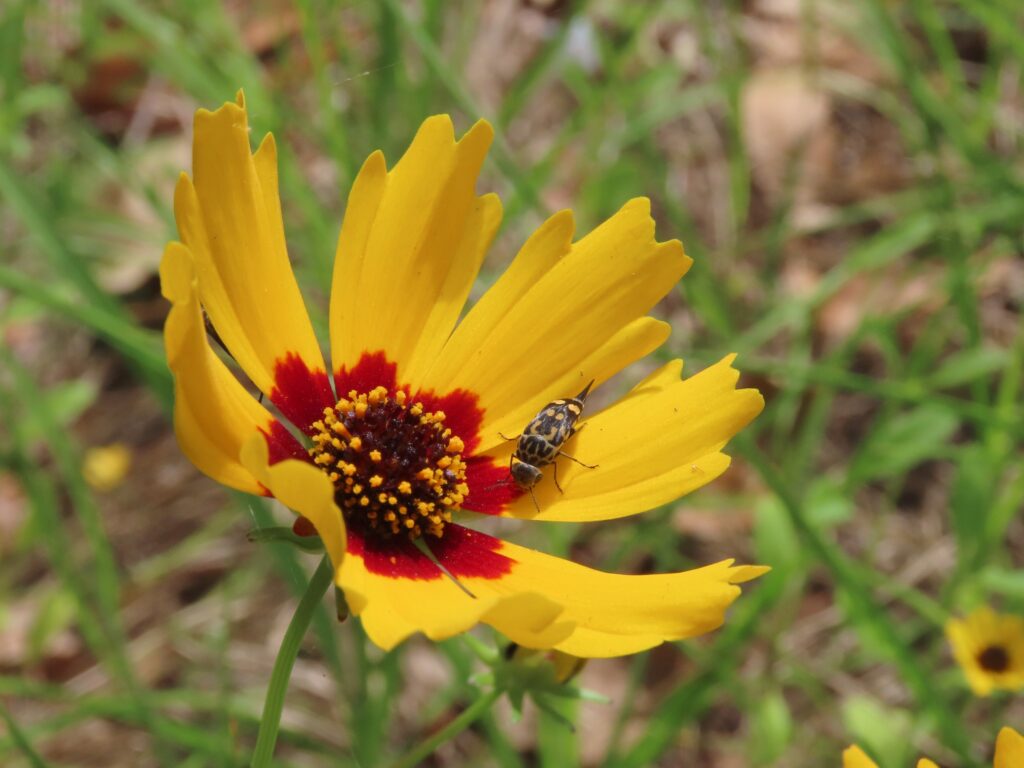
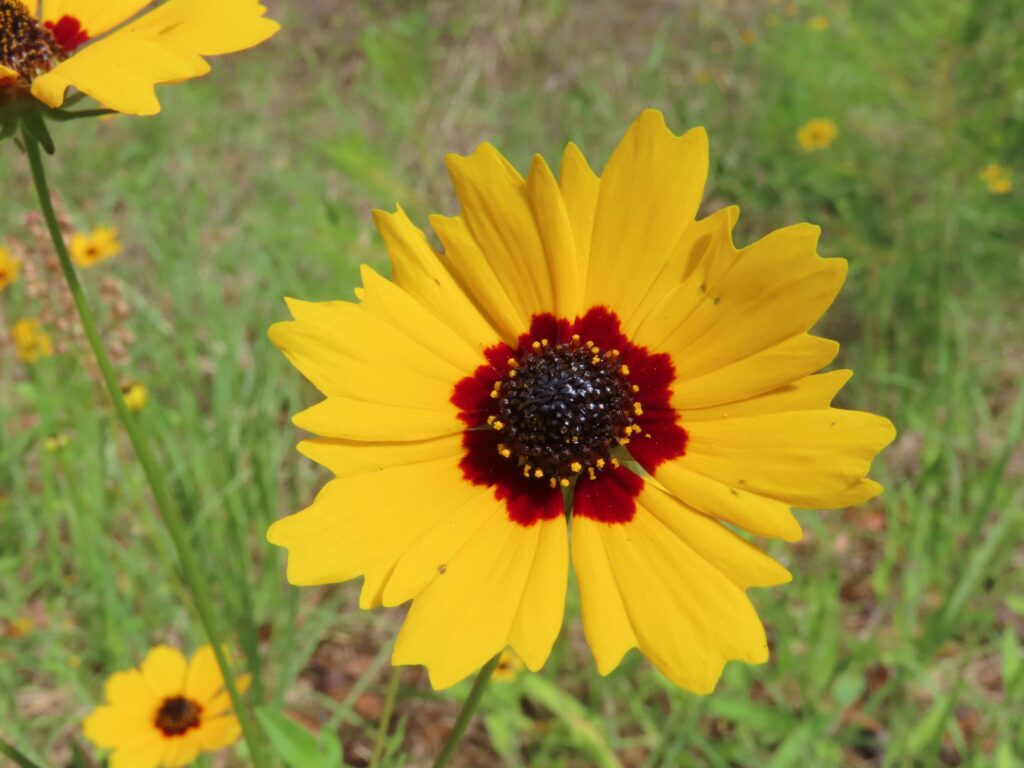
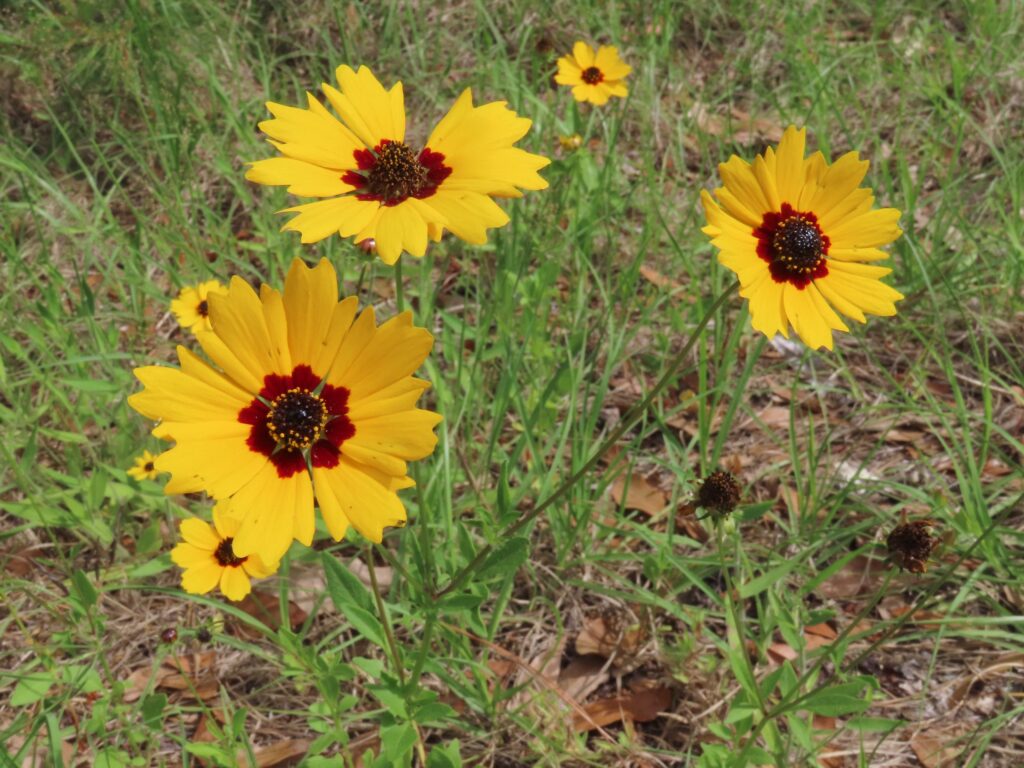
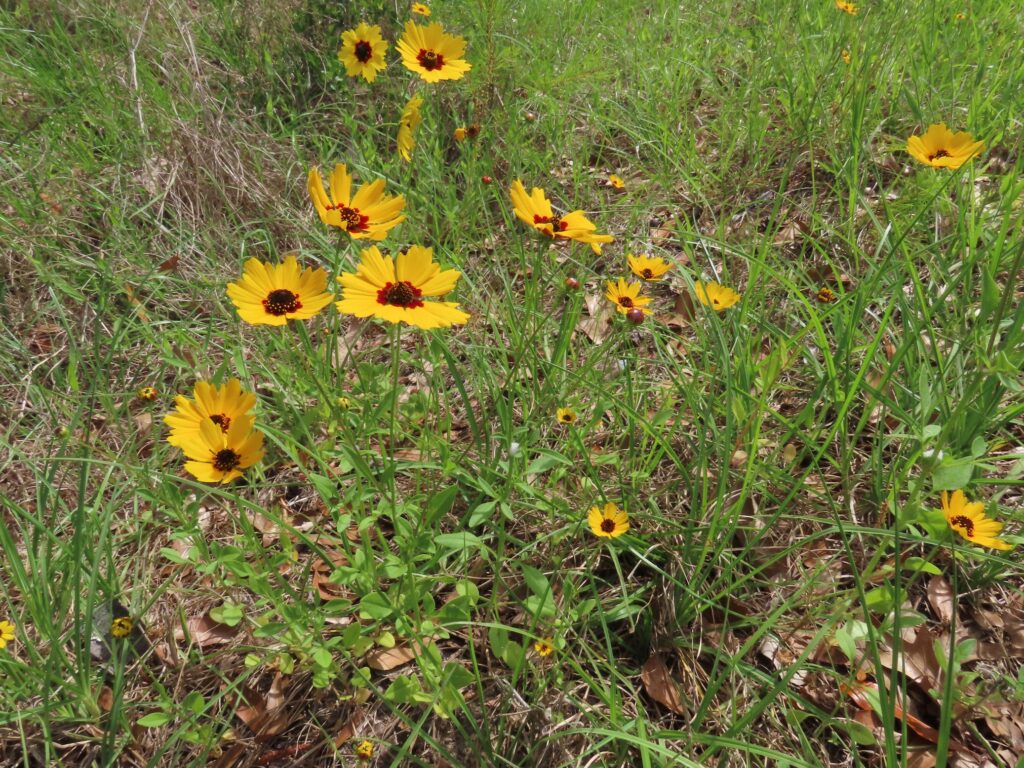
This week for Flora and Fauna Friday it’s the golden glow of a sandy mid-spring road, Goldenmane Tickseed (Coreopsis basilis).
A small sea of rich yolk-yellow flowers, inch wide with black cores ringed in a corona of crimson, flutters and flows over the drafty shoulders of our rural Island roads. Every year as spring enters full swing our Goldenmane Coreopsis is abloom. It’s a plant that’s native to the Gulf Coast but has long since established a foothold in the coastal plain of the Southeast. It’s a drought tolerant annual with a love for sunny roadsides, meadows, and lawn edges. In the right conditions, they can fill an entire field to the brim with glimmering golden petals. Leaves are deeply lobed and flowers borne individually on long, skinny stalks. Each plant grows singly and reaches about twelve inches in height. Goldenmane Coreopsis does fantastic in gardens and will readily volunteer year after year.
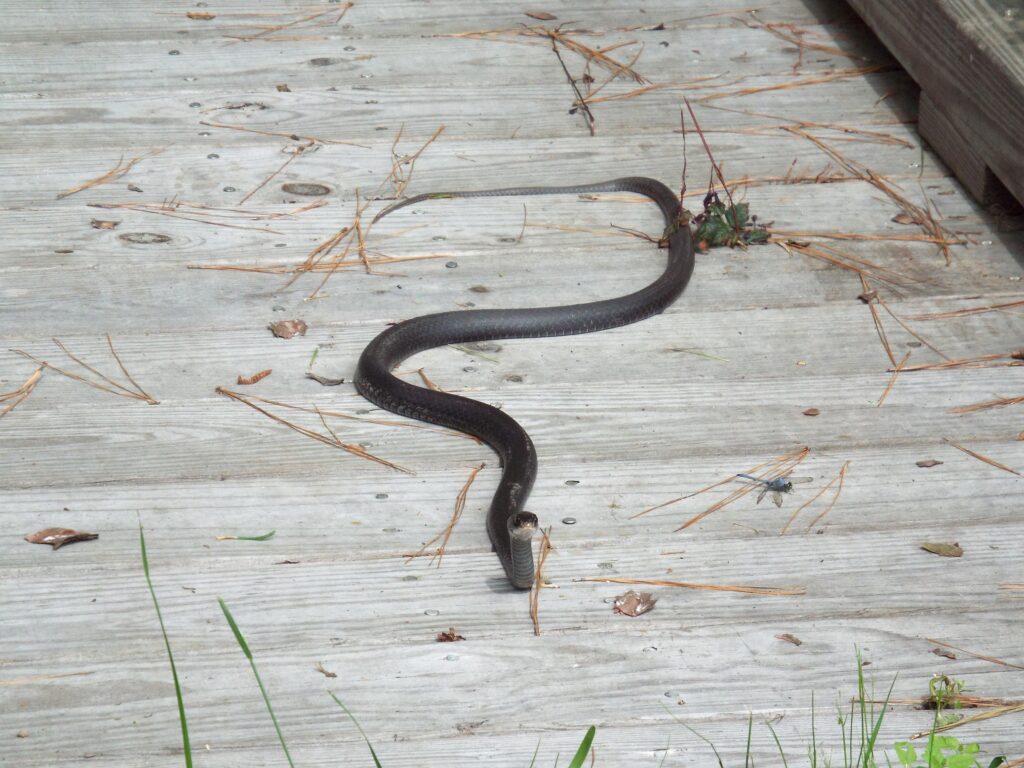
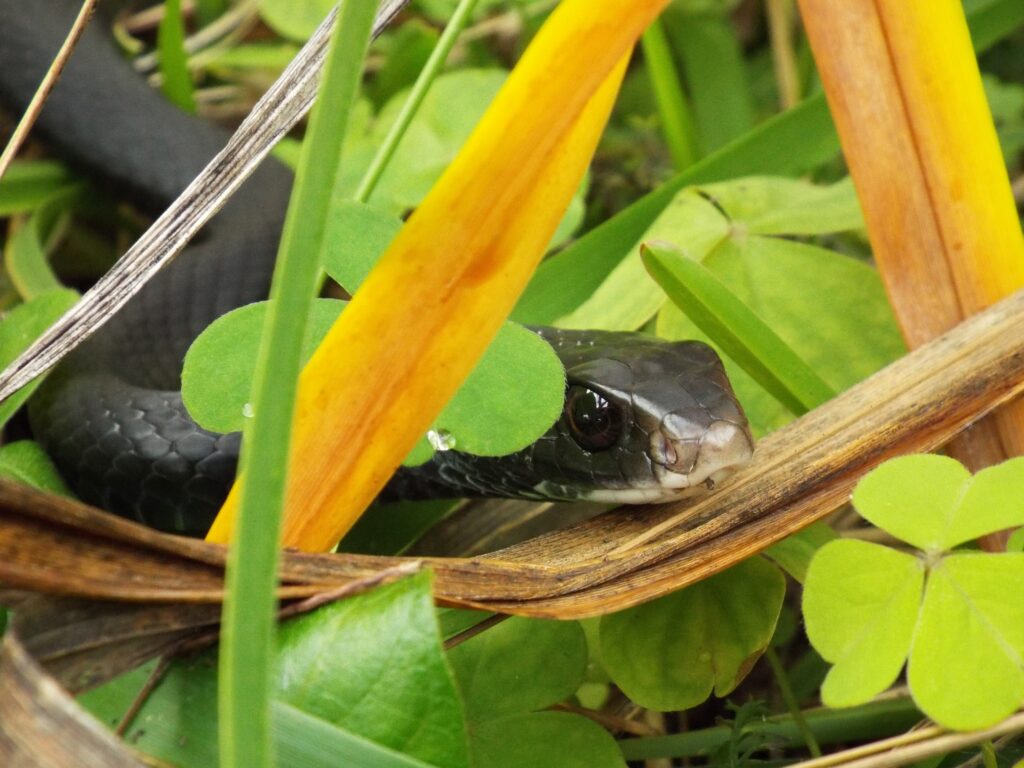

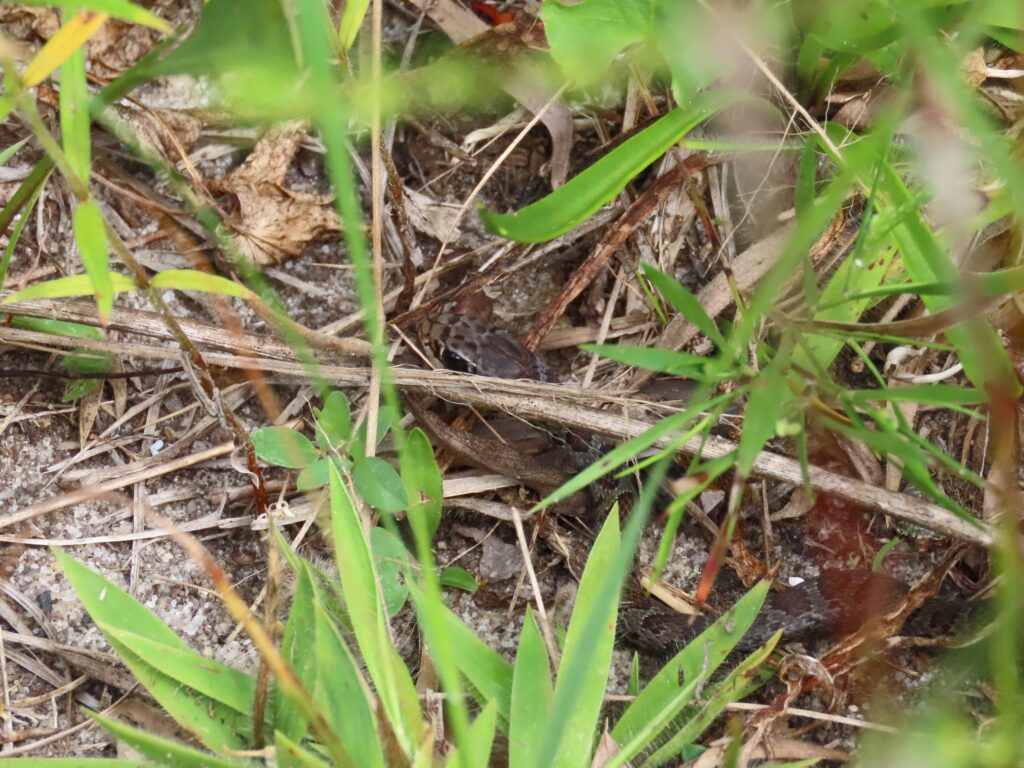
This week for Flora and Fauna Friday it’s our most common slithering friend, the Southern Black Racer (Coluber constrictor priapus).
The Southern Black Racer is the subspecies of Black Racer found here in the Lowcountry. The Black Racer is a spindly snake with a long thin body, small head, large eyes, and semi-gloss black coloration, often with a white chin as its sole accent. Juveniles are phosphate-gray with ruddy-brown blocky blotches down their back. Adults can reach five feet in length but are usually three to four feet long. Black Racers can be found practically anywhere in the state, especially along woodland edges. They’re probably our most commonly seen species of snake on Edisto Island and usually one of the first to stir in spring. Unlike many other snakes, Black Racers are diurnal and hunt during the day. They hunt a wide range of prey including mice, skinks, birds, frogs, and insects using their exceptional speed for a snake. They will also raid low-lying bird nests but are not as adept at climbing as the Rat Snake. Black Racers hunt by sight and don’t constrict their prey, so they generally only eat small critters that don’t put up much of a fight. Another interesting trait of Black Racers is their preference for fleeing over camouflage. Most snakes stay stock still when approached or will coil up in defense. Black Racers, however, turn tail and scurry away as fast as possible. You’ll generally spot one coiled up on a log sunbathing or surveying the forest floor with its head held half a foot above the ground. If you get too close or move abruptly, they’re gone in a flash. Yet, when cornered, Racers are feisty and will not hesitate to strike and bite anything that gets too close. Despite this, they’re nonvenomous and totally harmless to people and all but the smallest of poultry.
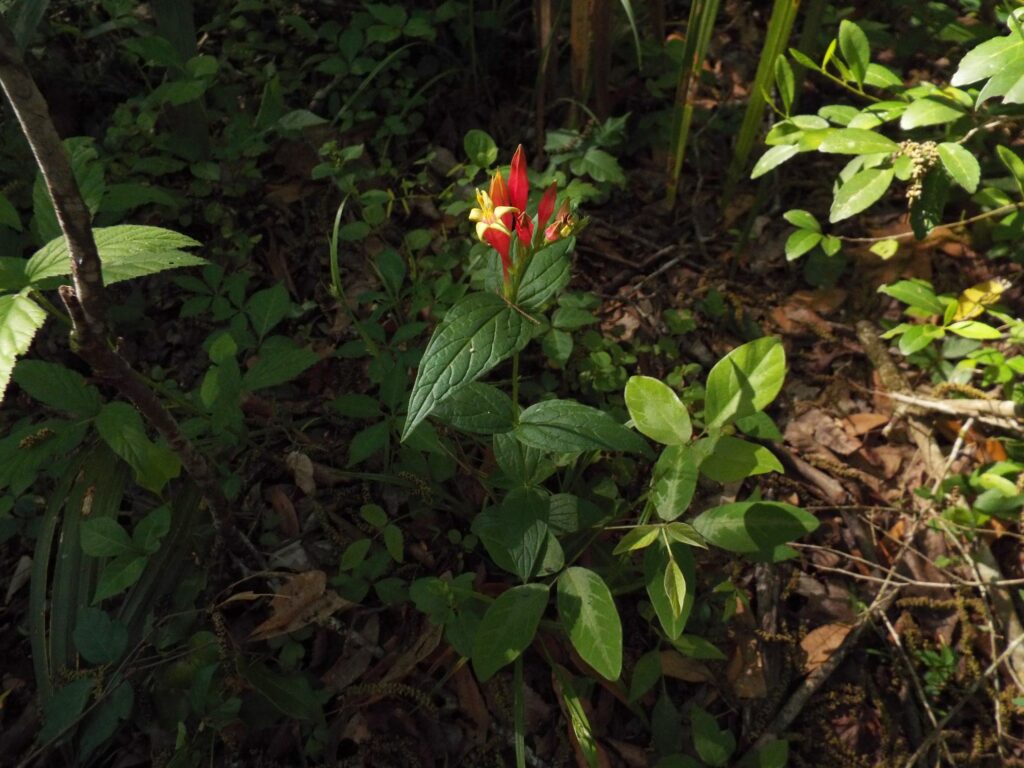
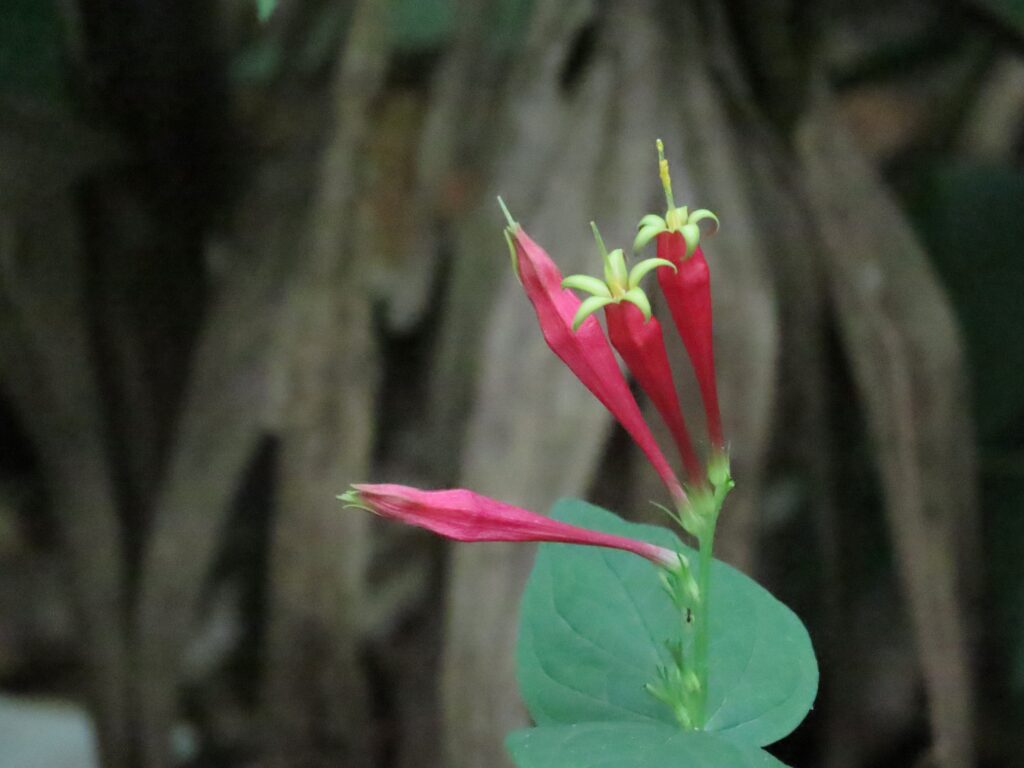

This week for Flora and Fauna Friday we have a two-toned forest flower found in the freshwater floodplains of the Edisto, Indian Pink (Spigelia marilandica).
Along the banks of the South Edisto and in river valleys across the South, Indian Pink blooms each spring, peaking in May. Indian Pink is a low growing, perennial wildflower partial to moist, nutrient rich soils. It tolerates deep shade and spreads into dense clumps. Its leaves are a deep green, almost triangular in shape, and held opposite each other. Atop the foliage the flowers are held upright in one-sided spikes. Each five-petalled flower is trumpet-shaped with a crimson-red exterior and golden-yellow center. These flowers are pollinated by hummingbirds and provide a welcome flare of color to the deep understory of floodplain forests. Indian Pink is by no means a common plant but it is a native and one that is well adapted to garden conditions. It thrives in the moist, rich soils and dappled sun of a shaded garden bed and its attractive appearance, to both man and Hummingbird, ensure it will be an appreciated addition to any backyard botanical project.
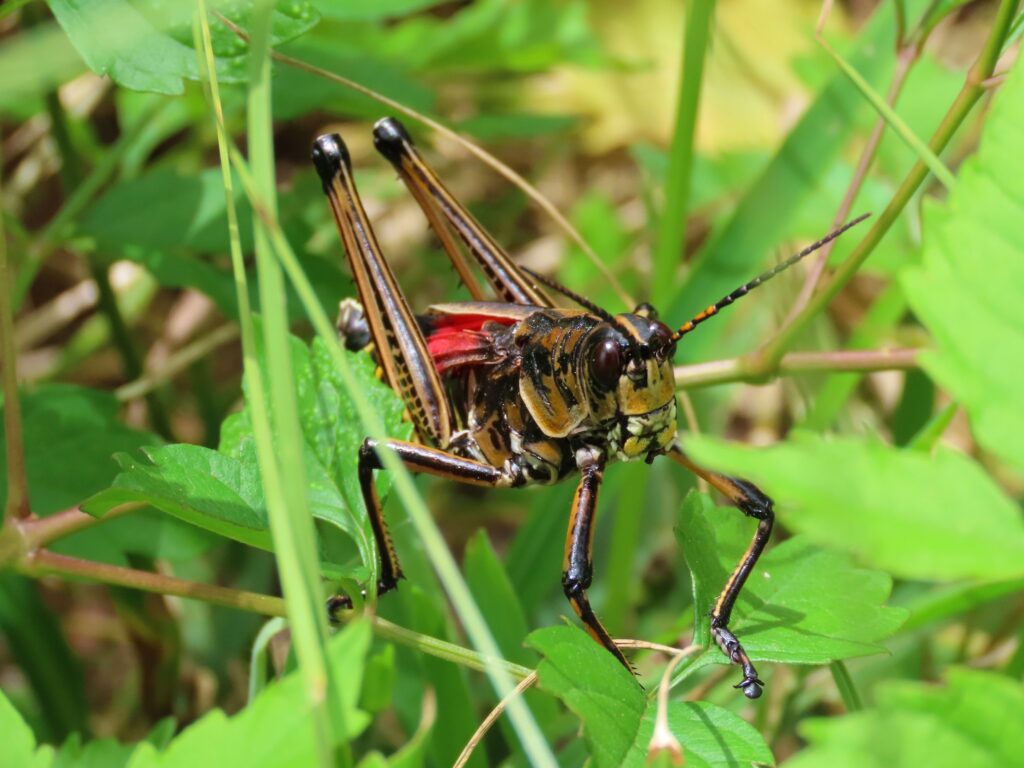
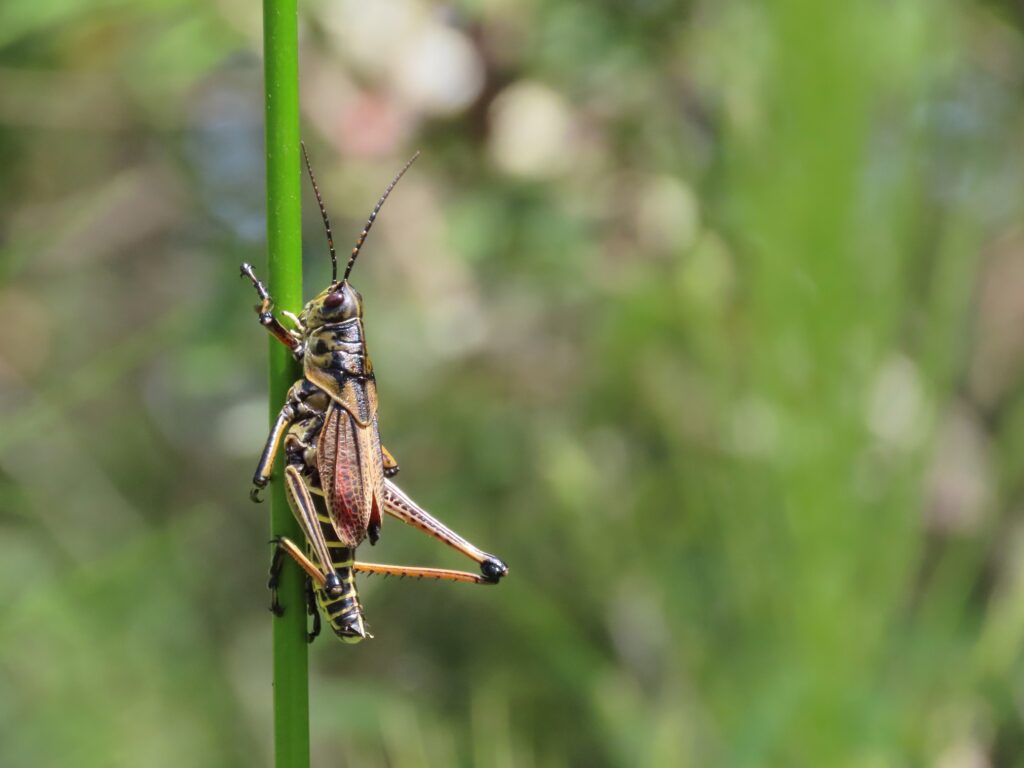
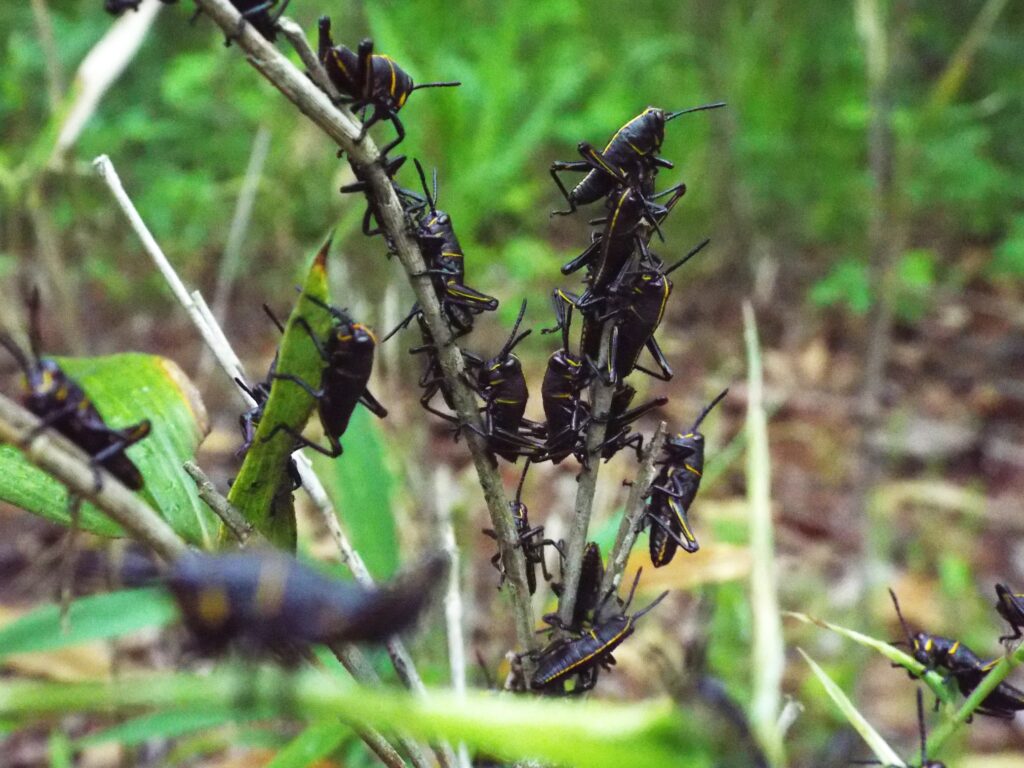
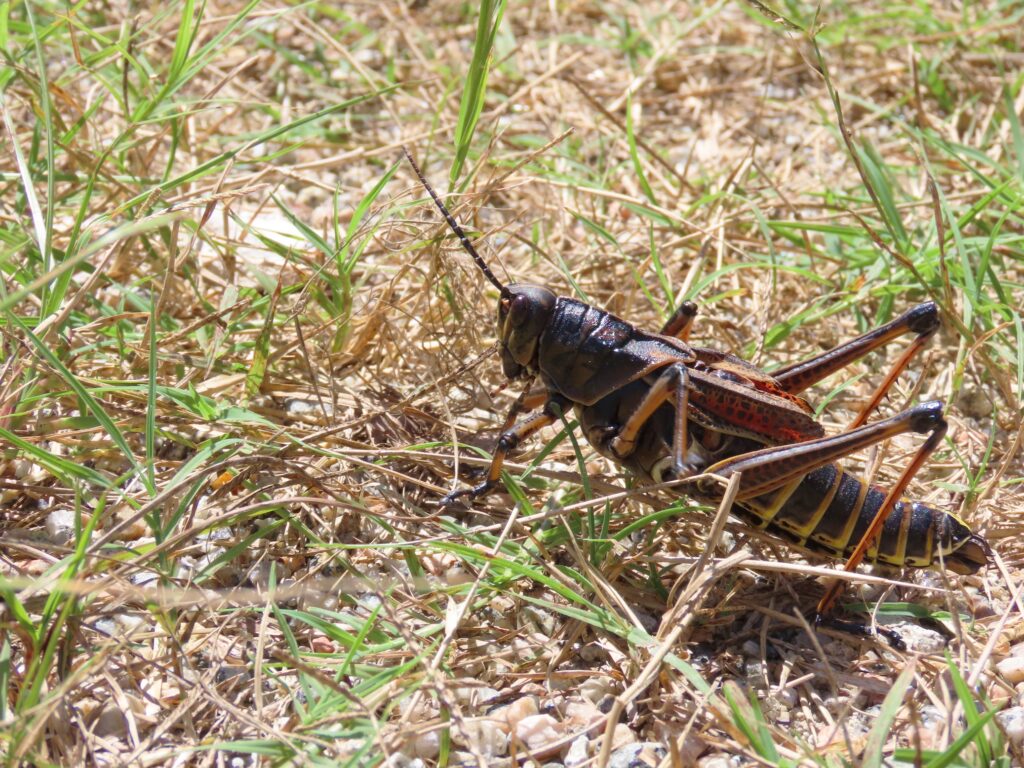
This week for Flora and Fauna Friday we’re taking in the sight of the big, bold, lumbering Eastern Lubber Grasshopper (Romalea guttata).
Each spring, wellsprings of bubbling black masses flow forth from our swamps to scour the forests and freshwater marshes of the Lowcountry. Swarms of Eastern Lubber nymphs emerge from the soil to begin their lives on the surface. Lubber nymphs are about a half-inch long, wingless, and matte-black with lemon-yellow highlights along the fringes of their bodies. Nymphs first start appearing in spring, usually in April, and they will slowly mature throughout the year until they become full-sized adults by September. Adults are downright huge, often three and sometimes four inches in length with a stout, hefty body. Their coloration varies from sunflower-yellow with accents of black and scarlet to nearly solid black with highlights of dingy yellow and red. Adults have tiny, nonfunctional wings and must clumsily saunter and lumber their way over the ground to get anywhere. You’d think this would make them a sitting duck for predators but that bright yellow and red coloration signals their toxicity. Lubbers naturally assimilate plant toxins into their flesh throughout their lives while feeding on a broad selection of forbs and shrubs. They will eat many ornamentals plants that are well known to be toxic and which are avoided by most herbivores. This makes them particularly unpalatable as each Lubber is poisonous in a slightly different way from each of its neighbors. It all depends on what plants it ate growing up. Additionally, they are able to release a foamy chemical cocktail from their sides in order to poison any predator that ignores their warning colors and takes a bite. Other than that, they are harmless to people. Despite their lack of flight, they can climb as well as any grasshopper and their large size means they have a big appetite. They can defoliate shrubs and crops but thankfully they’re scarce enough in South Carolina to never be much of a threat to our farms. However they can wreak a bit of havoc down in Florida.
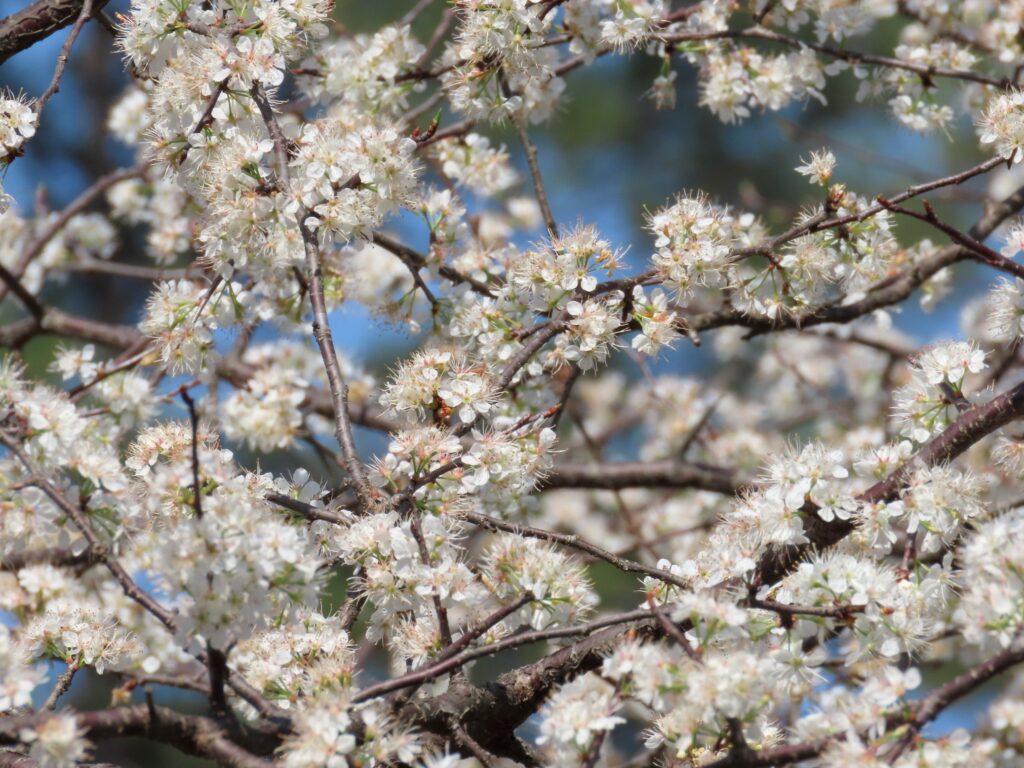
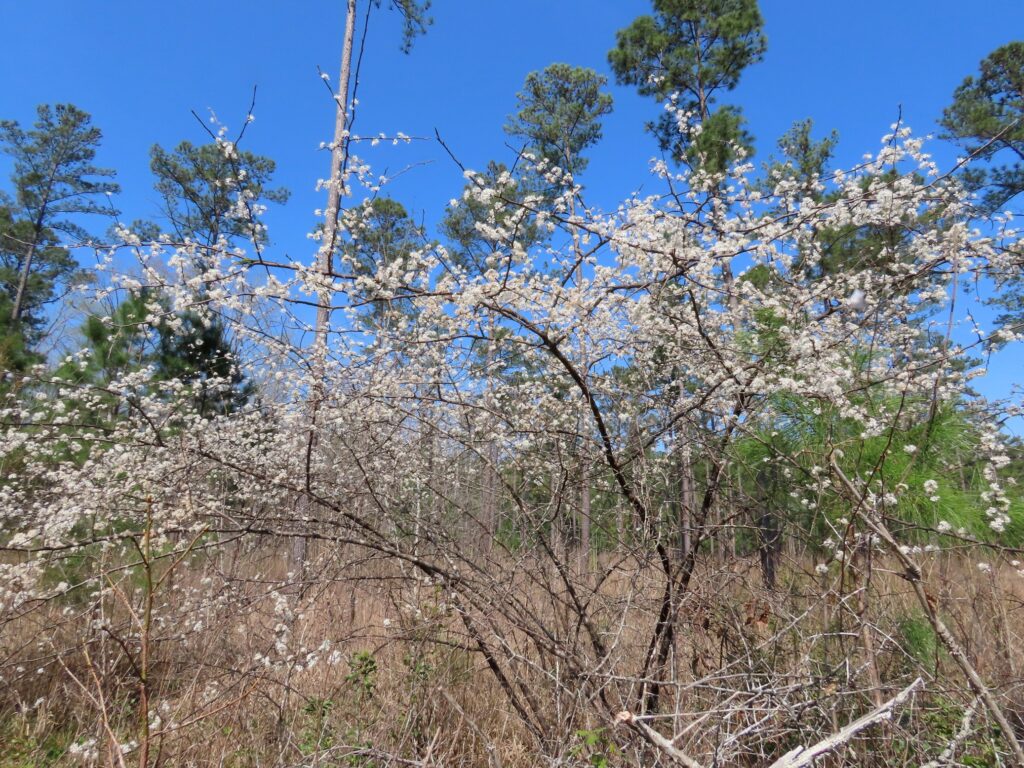
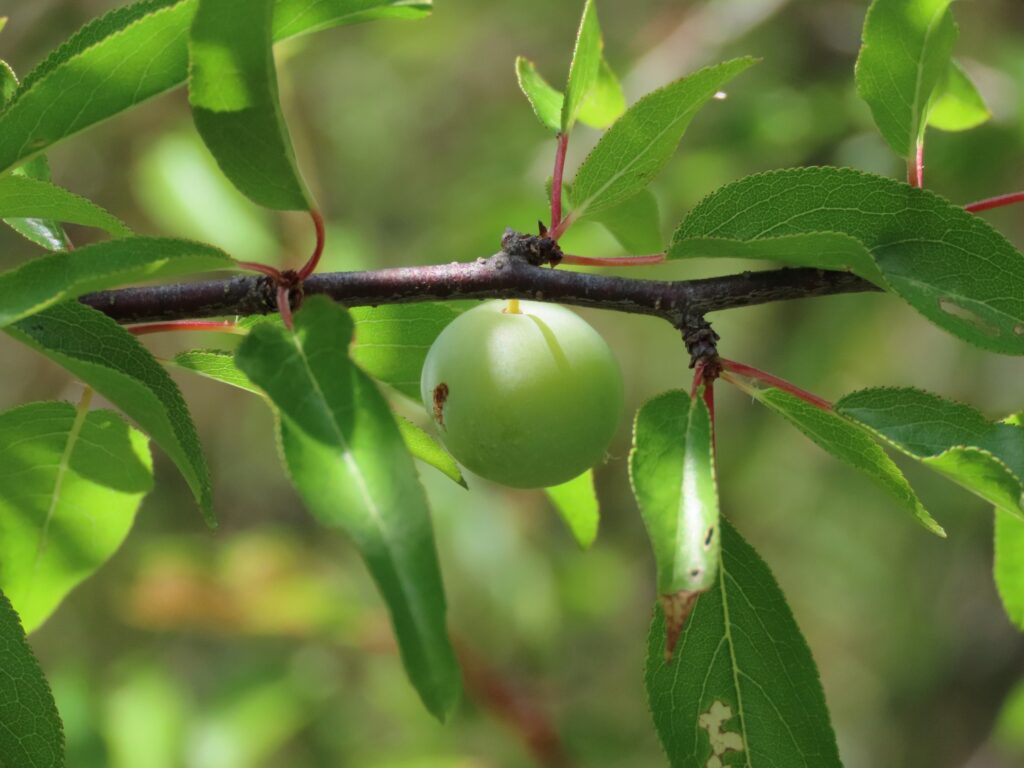
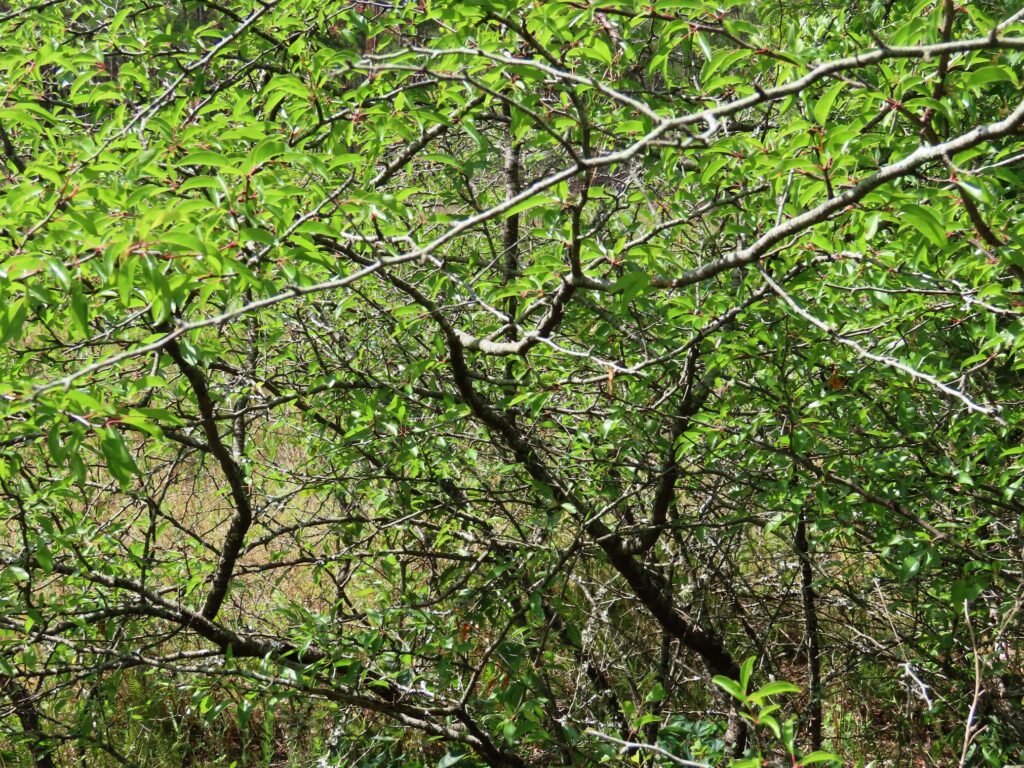
This week for Flora and Fauna Friday is a drought tolerant bush with an edible fruit, the Chickasaw Plum (Prunus angustifolia).
The Chickasaw Plum is large shrub to small tree found throughout South Carolina. It has a broad bushy growth and will often spread clonally into a small thicket. It’s tolerant of drought and will grow well on most deep soils either in full sun or partial shade. Chickasaw Plum has simple, narrow leaves with a finely toothed margin and is deciduous. In early spring, before its leaves appear, Chickasaw Plum will burst out into a profusion of small white flowers. They bloom from March until May all the while abuzz with bee and other pollinator activity. Through the spring it will set fruit and over summer these will mature into small, inch-wide golden-yellow or peach-colored fruits. These fruits are edible raw or can be sweetened and canned to make jellies and preserves. However, they’ll often be gobbled up by Orioles, Mockingbirds, and Raccoons before you ever get a chance to pick them. The foliage of the Chickasaw Plum is also food for the larvae of several butterfly species, including the Eastern Tiger Swallowtail, Viceroy, and Red-spotted Purple.
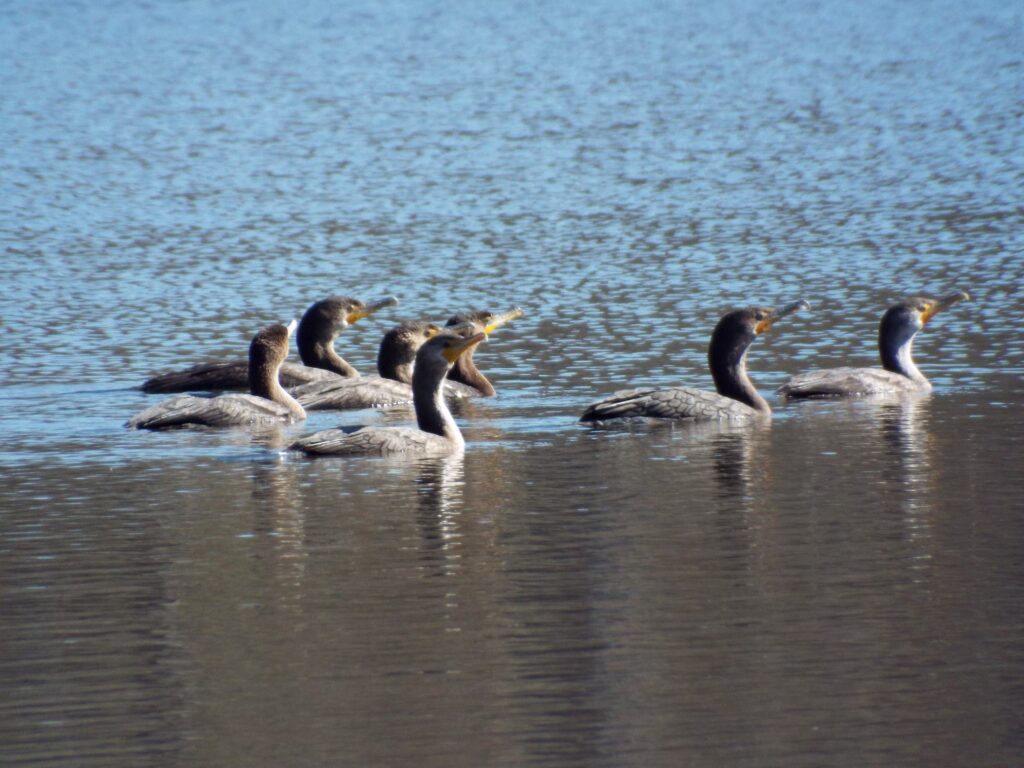
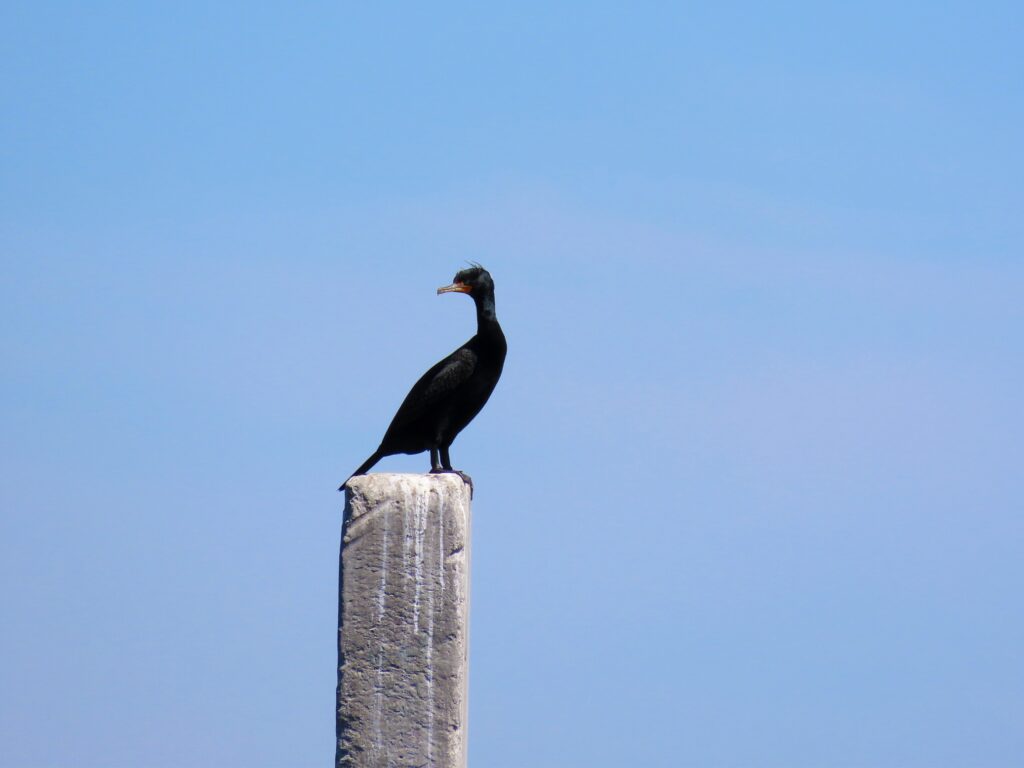
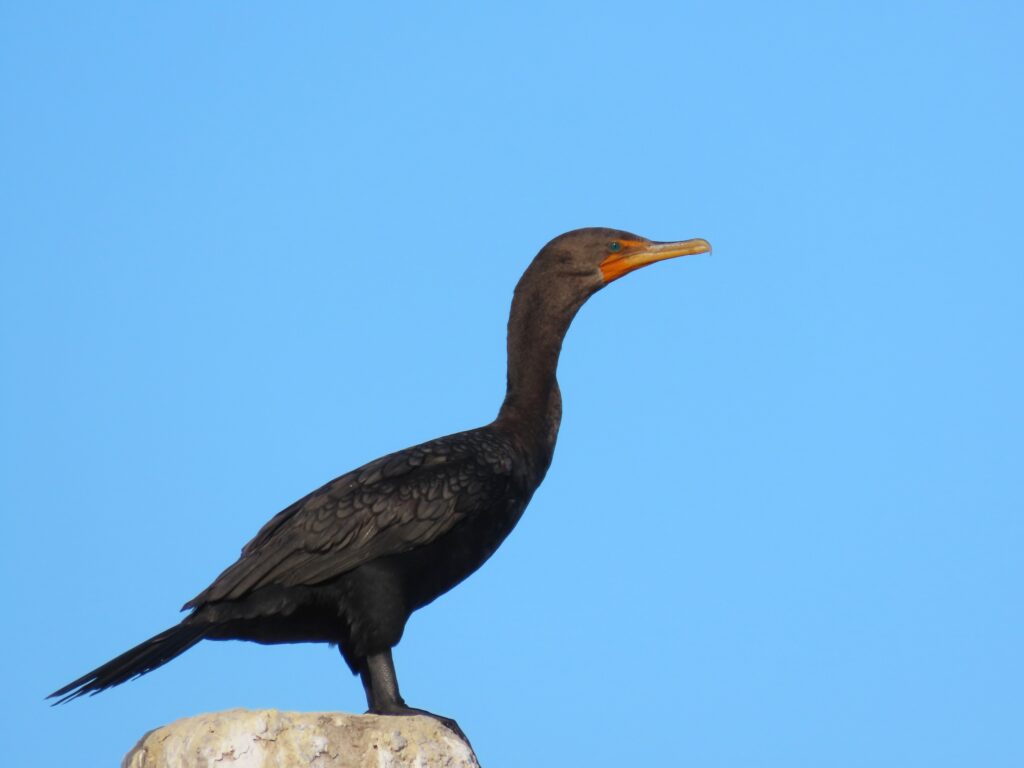
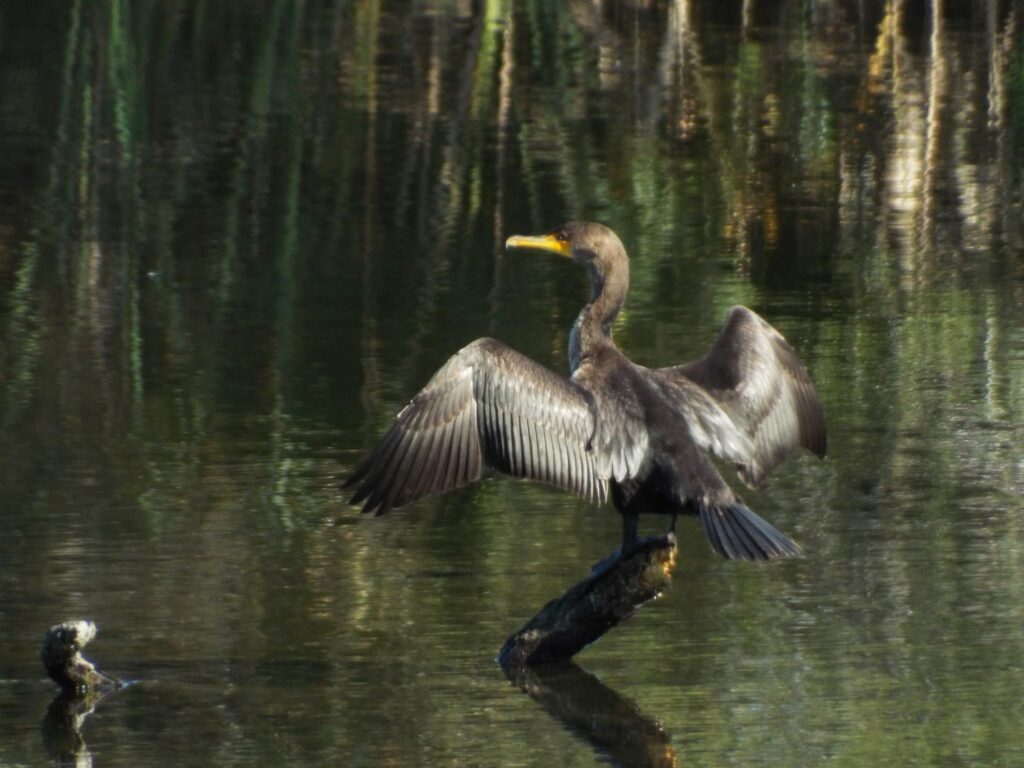
This week for Flora and Fauna Friday it’s a widespread, weird looking waterbird, the Double-crested Cormorant (Nannopterum auritum).
The Double-crested Cormorant is a bird unlike any of our others. At about the size of a small, svelte goose but with a straight posture and a heavy bill, there’s nothing else that has the same silhouette. The Anhinga is their closest relative in SC but that odd-duck is even less like anything else in our State. Our Cormorant can be found along our coast year round but is most numerous in winter. Adult birds are jet black across the body during the breeding season but their necks and wings take on a more drab ebony hue in the off season. Juvenile birds have a grungy pale-gray belly blending into an equally gungy gray-brown neck. All ages have orange skin at the base of the beak and an aquamarine colored eye. The beak is fairly long and heavy with a sharp hook at the tip of the upper jaw. Their namesake “double-crest” is hard to see except in the breeding plumage of adults who flaunt a pair of thick eyebrows which flare up into cowlicks along the side of the head. Cormorants have stout black legs and webbed feet and can often be spotted standing either straight-backed and statuesque or with wings out-stretched like a sunning vulture atop a pylon, dock, or jetty. Yet, equally as often they can be spotted paddling in a creek, lake, or pond with their neck and a bit of their back exposed on the surface. Cormorants are divers and they propel themselves beneath the water with powerful paddling in pursuit of fish. They have feathers that are partially permeable to water, allowing them to dive more efficiently but still retain some buoyancy and insulation. This is why Cormorants are often seen perched with wings outstretched, as they are drying their feathers. Here on Edisto Island, Double-crested Cormorant can be spotted foraging or perched by themselves but are more often seen in groups ranging from a few to several dozen birds. Elsewhere on colony breeding grounds, they can even be found in the thousands!
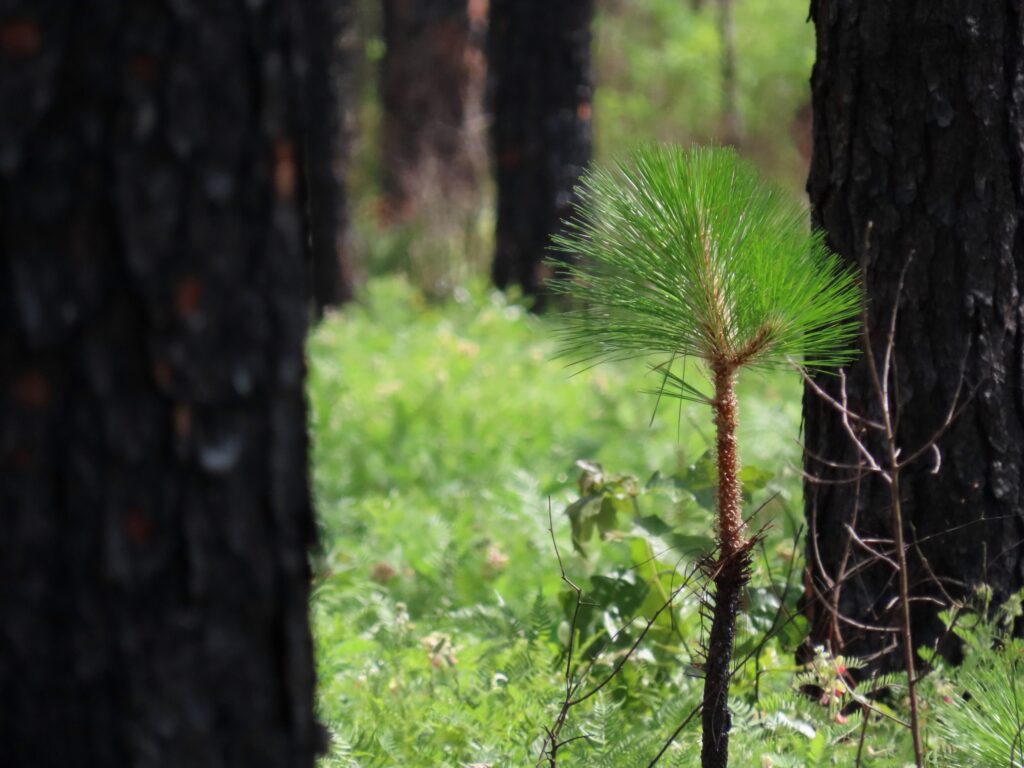
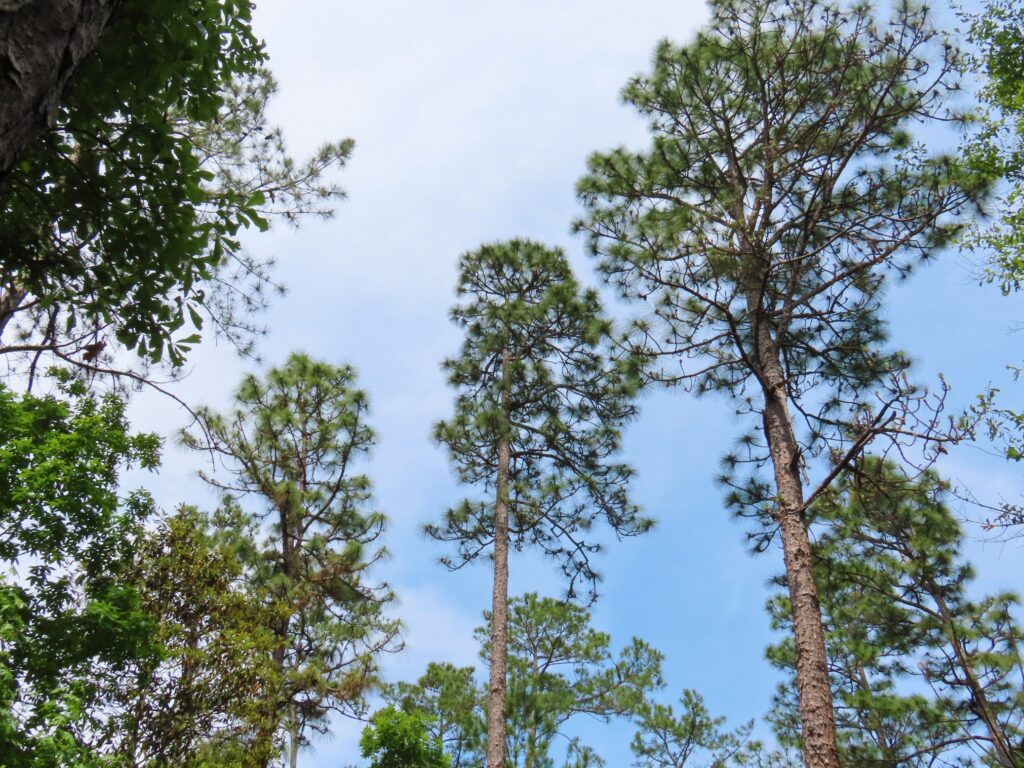
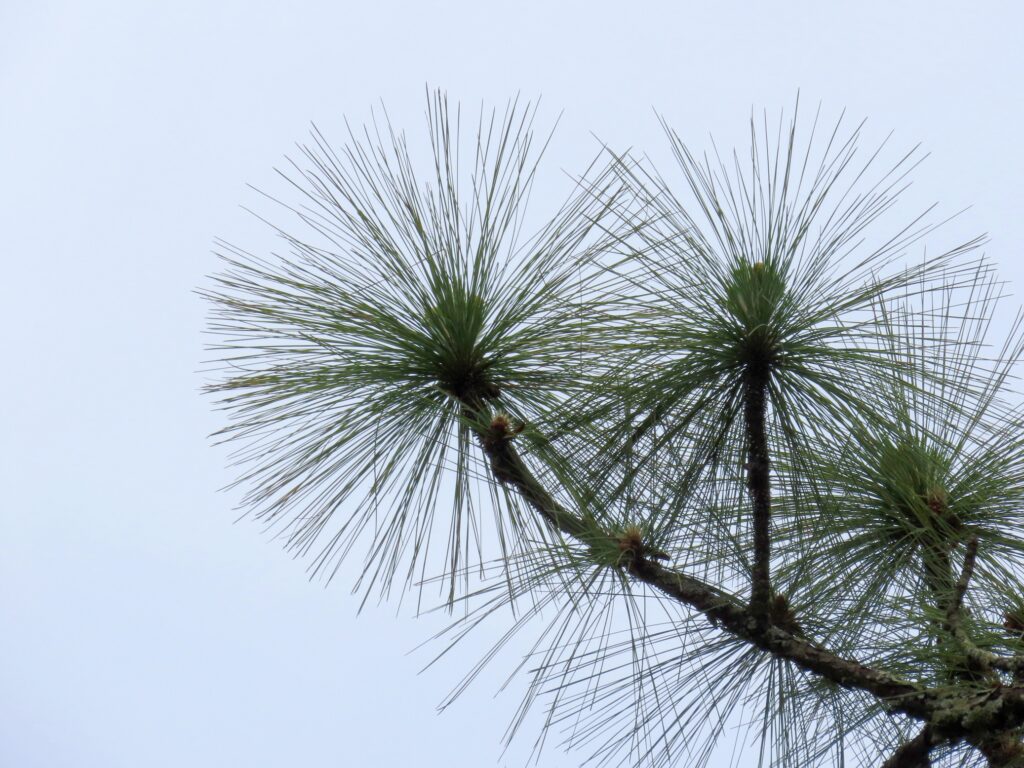
This week for Flora and Fauna Friday it’s the mighty Pine that dominated the pre-colonial Southeast, the Longleaf Pine (Pinus palustris).
The Longleaf Pine is an ecoregion defining tree which once reigned in the coastal plain from Alabama through North Carolina. However, by the mid-twentieth century its kingdom had been hacked to pieces and its numbers whittled to just a small fraction of what it once was. Longleaf Pine is a long-lived pine with a broad crown, stout arrow-straight trunk, and relatively dense wood for a pine. This pine has long emerald-green needles which burst forth from thick spiny stems into globes of dangling threads. Between these its huge cones perch in the breeze, spilling winged seeds to the forest floor. Beneath the ground it extends a deep twining bed of roots, anchoring it to the sandy soils it inhabits. Longleaf Pine at a glance resembles both the ubiquitous Loblolly Pine (P. taeda) and especially the more southern Slash Pine (P. elliottii) but when more closely examined is easily recognized by its needles of unmatched length, thick stems, and massive cones, which dwarf those of Loblolly.
The Longleaf Pine was once found extensively throughout the Lowcountry and Sandhills of South Carolina. Outside of river valleys and swamps, it was likely the dominant tree throughout the Lowcountry. Great savannahs stretched for miles on end with a sea of grasses and shrubs sheltered beneath a cloud-like canopy of Longleaf Pines. This open canopy and grassy forest floor were maintained by periodic fires, set naturally by lightning strikes or intentionally by Native Americans. Longleaf Pine was built for fire. Its bark is thick and corky and its stems finger-thick even at their narrowest, insulating it from the heat of even a summer blaze. Young trees grow like a grass on the ground, pumping their energy into building an expansive root system and storing energy so they can quickly shoot up a spindly trunk above the reach of the average fire. Their adaptation to fire also came hand-in-hand with their tolerance for drought, as dry soils were often more at risk for fire. Their deep and expansive root system allowed them find water and nutrients on even the deepest, driest, most barren sand hills of the midlands and a refined tolerance for heat allowed them to reduce their water uptake dramatically in periods of prolong drought. These traits coupled with their longer lifespan allowed them to eventually dominate the Southeast and convert the land to savannahs. As the sun raged, fires blazed, and droughts persisted they were the only canopy tree that could survive in many places. Beneath their boughs a rich and diverse fire kindled landscape developed full of endemic species of wildflowers, grasses, birds, reptiles, and insects that could survive nowhere else.
During the European colonization of the Southeast, these vast savannahs were logged for their timber and the more arable lands converted to farms and pastures. Some Longleaf Pine groves were continuously maintained for the production of pine resin, which was converted into naval stores. Quickly the Longleaf Pine forests became fragmented and great fires no longer carried for miles on end. However, many areas were still intentionally burned by European Americans to improve cattle forage and hunting. The pattern of fragmentation and conversion continued to worsen. In the 1930s, large scale fire suppression was widely implement across the country and the few intact Longleaf Pine ecosystems suffered greatly for it. For over fifty years, fire suppression wreaked havoc on these sensitive fire-dependent ecosystems. However, modern foresters and ecologists have re-embraced fire on the landscape and coordinated efforts by federal, state, and nonprofit entities are well on their way to returning Longleaf Pine back to a considerable portion of the southeastern landscape.